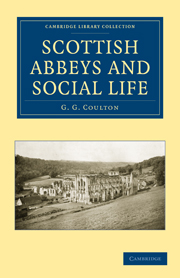Book contents
- Frontmatter
- Contents
- LIST OF ILLUSTRATIONS
- Preface
- Chapter I Celtic Monachism
- Chapter II The Monastic Rules
- Chapter III Monastic Revenues
- Chapter IV How Endowments Came (I)
- Chapter V How Endowments Came (II)
- Chapter VI Monks and Parishes (I)
- Chapter VII Monks and Parishes (II)
- Chapter VIII Charity (I)
- Chapter IX Charity (II)
- Chapter X Monk and Peasant (I)
- Chapter XI Monk and Peasant (II)
- Chapter XII Monastic Housekeeping
- Chapter XIII Church and Scriptorium
- Chapter XIV The Monastic Chronicler
- Chapter XV Schools
- Chapter XVI Art and Learning
- Chapter XVII Professions and Business
- Chapter XVIII Visitation (I)
- Chapter XIX Visitation (II)
- Chapter XX A Voice from the Cloister
- Chapter XXI Conclusion
- Appendixes
- List of Authorities
- Index
Chapter VI - Monks and Parishes (I)
Published online by Cambridge University Press: 05 August 2011
- Frontmatter
- Contents
- LIST OF ILLUSTRATIONS
- Preface
- Chapter I Celtic Monachism
- Chapter II The Monastic Rules
- Chapter III Monastic Revenues
- Chapter IV How Endowments Came (I)
- Chapter V How Endowments Came (II)
- Chapter VI Monks and Parishes (I)
- Chapter VII Monks and Parishes (II)
- Chapter VIII Charity (I)
- Chapter IX Charity (II)
- Chapter X Monk and Peasant (I)
- Chapter XI Monk and Peasant (II)
- Chapter XII Monastic Housekeeping
- Chapter XIII Church and Scriptorium
- Chapter XIV The Monastic Chronicler
- Chapter XV Schools
- Chapter XVI Art and Learning
- Chapter XVII Professions and Business
- Chapter XVIII Visitation (I)
- Chapter XIX Visitation (II)
- Chapter XX A Voice from the Cloister
- Chapter XXI Conclusion
- Appendixes
- List of Authorities
- Index
Summary
In this chapter, we come to one of the main sources of monastic revenues; namely, those which were drawn from parish churches. In England, where the Reformation was comparatively conservative, there still subsists the medieval distinction between benefices; some are rectories, others are vicarages. In medieval Scotland, there was the same distinction, and the same reason for it. The normal parish was served by a rector, who took all the legal revenues of the parish. But about onethird of the English parishes had gradually come into the hands of monasteries or cathedrals or great collegiate churches; in that case, the monastery had all the rectorial rights, and left the parish duty to be done by a hired substitute, who was called by the ordinary Latin name for all kinds of substitutes, vicarius.
By early Christian law, the parish revenues were supposed to be divided into four portions; later on, this theory was changed to three; one for the parish priest himself, one for the upkeep of the church and services, and one for the poor and for hospitality. There is no recorded instance, so far as I know, of this division being strictly carried out; but such remained the theory throughout the Middle Ages. The main income of the parish (two-thirds of it at least) came from the teinds, or tithes; all men were bound to tithe not only their crops and their animals, but in many places their personal earnings also. We may form an idea of the minuteness of this income-tax, and its heavy incidence, from the following legal specification for a parish which had been appropriated to Newbattle.
- Type
- Chapter
- Information
- Scottish Abbeys and Social Life , pp. 76 - 90Publisher: Cambridge University PressPrint publication year: 2010First published in: 1933

